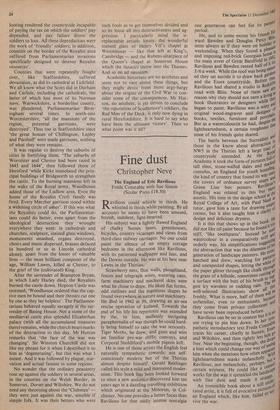Fine dust
Christopher Neve
The England of Eric Ravilious Freda Constable with Sue Simon (Scolar Press £18.50)
Ravilious could whistle in thirds. He whistled in thirds while painting. By all accounts he seems to have been amused, boyish, indolent, light-hearted.
His subject was a lightly flawed England of chalky Sussex lanes, greenhouses, bicycles, country vicarages and views from third-class railway carriages. No one could paint the silence of an empty cottage bedroom in the afternoon like Ravilious, with its patterned wallpaper and lino, and the Downs outside. He was at his best near Lewes in the Thirties.
Strawberry nets, flint walls, ploughland, fences and telegraph wires, watering cans, farm machinery and mackerel skies were what he chose to draw. He liked flat forms, odd outlines and the ingenious shapes he found everywhere in nature and machinery. He died in 1942 at 39, drawing an air-sea rescue operation of Iceland. Towards the end of his life his repertoire was extended by the, to him, endlessly intriguing paraphernalia of war though he could hard- ly bring himself to take the war seriously. Tiger Moths, he drew, and guns and wire on familiar pre-war cliffs; convoys, and Corporal Steddiford's mobile pigeon loft.
He is one of those artists the English feel naturally sympathetic towards: not self- consciously modern but of the Thirties almost despite himself. Gerald Reitlinger called his style a mild and mannered moder- nism. This book has been looked forward to since a new audience discovered him ten years ago in a dazzling travelling exhibition which originated at the Minories, in Col- chester. No one provides a better focus than Ravilious for that oddly intense nostalgia
one generation can feel for its Pate° period. He, and to some extent his friends Ed. ward Bawden and Douglas Percy Diisri; seem always as if they were on holidaci't weekending. When they found a pleas1,0 and imposing red-brick Georgian hoii, the main street of Great Bardfield in ",'„r Ravilious and Bawden rented half of it '"d, 3/6 a week. While the roof was being nt,eriris ed they sat astride it to draw back gatti and the Essex countryside. Before Ravilious had shared a studio in Retici,Py road with Bliss. None of them say;as reason why they should not earn a living y book illustrators or designers while t,I,Ined began to paint. Ravilious was a wittY original wood-engraver and designer ." books, textiles, furniture and Porcelaihrie But as a watercolourist he had, despitelat lightheartedness, a certain toughness DI none of his friends quite shared. .nd • The battle between the Surrealists those in the know about abstraction If NW5 in the Thirties left a large tract ;I countryside untended. At the Academy it took the form of pictures In"ej tall elms, stone-walled dales and stae„kn,
'
cumulus, an England for youth hoste70 the kind of country that found its waY d the covers of ordnance survey Green Line bus posters. Ravii,-re England was related to this but Pile ascetic. His time in the design school at Royal College of Art, with Paul Nash ; tutor, gave him a taste for drawing ett1P0f rooms, but it also taught him a claritY
design and delicious dryness. - 146
It is this that shows up in the boo. 00 did not like oil paint because he found it t,e,cj stiff, 'like toothpaste'. Instead he and watercolour in a comparatively stiff Fog orderly way, his simplifications sugges;05 the abstraction that was the dilemma °`,55. generation of landscape painters. He hatched and drew, watching for Pat,`, of and unexpected shapes, letting the whits",b the paper glitter through like chalk throtiu% the grass of a hillside, sometimes cutting; a surface with the butt of his brush gest icy wavelets or rodding rain. Thethis well-selected illustrations show freshly. What is more, half of the rn wl` use unfamiliar, even to enthusiasts, heea„ncl they come from private collections have never been reproduced before. Ravilious can be set in context but it l‘ntis use trying to pin him down. In her sji71; pathetic introductory text Freda Con 00 traces his career, chiefly in Sussex, go and Wiltshire, and then rightly lets hitri, eots free. Near the beginning, though, she dr; a hint which could change our way of se him when she mentions how often aPPrxitii lightheartedness masks melancholY. but a Ravilious, not melancholy, perhaPsent certain wryness. He could like a ce're works for the way it sprinkled the landse:. with fine dust and made it strangicer, An irresistible book about a still tinus of rated artist, it is full of evocative Picturecur- anEtnge r.lawnadwhich, like him, failed vive h t°










































 Previous page
Previous page